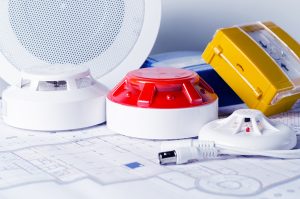
Understanding how NFPA 3 and 4 set the guidelines for integrated system testing can help you make sense of the importance of these systems.
Integrated system testing is a critical step in ensuring that complex fire protection and life safety systems work together seamlessly during an emergency. When multiple systems—such as fire alarms, sprinkler systems, smoke control, emergency lighting, and mass notification—are involved, they must operate in unison to protect people and property. This is where NFPA 3 and NFPA 4 come into play.
Understanding Integrated System Testing
Modern buildings rely on interconnected safety systems. A fire alarm may trigger sprinklers, initiate smoke control fans, close fire doors, and activate elevators for firefighter use—all within seconds. Integrated system testing ensures that these components communicate and respond correctly, providing a coordinated safety response.
Without thorough testing, a single point of failure in communication could compromise the entire protection strategy.
What is NFPA 3?
NFPA 3, Recommended Practice for Commissioning of Fire Protection and Life Safety Systems, focuses on the commissioning process. It provides a framework for ensuring that systems are designed, installed, tested, and maintained according to the owner’s requirements and applicable codes.
Key points of NFPA 3 include:
- Establishing an integrated testing plan early in the project.
- Verifying that individual systems meet performance criteria before integration testing begins.
- Coordinating between contractors, engineers, and the building owner.
While NFPA 3 is a recommended practice (not a mandatory standard), following it helps ensure a smoother and more reliable testing process.
What is NFPA 4?
NFPA 4, Standard for Integrated Fire Protection and Life Safety System Testing, is the enforceable standard that specifies how integrated system testing must be conducted. It applies to both new installations and retrofits.
Key points of NFPA 4 include:
- Requiring periodic integrated system testing to verify ongoing functionality.
- Assigning a qualified integrated testing agent (ITa) to oversee the process.
- Documenting all tests and providing detailed reports.
- Addressing both initial acceptance testing and ongoing periodic testing.
Unlike NFPA 3, NFPA 4 is mandatory where adopted by code, making compliance essential for regulatory approval.
Why Integrated System Testing Matters
The main goal of integrated system testing is to ensure life safety systems work together in real-world scenarios. Even if each system passes its own individual test, integration errors can occur.
For example:
- A fire alarm may activate, but if the signal doesn’t reach the smoke control panel, toxic smoke could spread.
- An emergency generator might start during a power failure, but if lighting circuits aren’t properly tied in, evacuation routes could remain dark.
Testing according to NFPA 3 and NFPA 4 helps identify and fix these issues before lives or property are put at risk.
Steps in an Integrated System Test
A typical integrated system testing process includes:
- Planning: Define systems involved, test sequences, and responsibilities.
- Coordination: Work with all stakeholders including contractors, engineers, and the AHJ (Authority Having Jurisdiction).
- Individual System Verification: Ensure each system works independently.
- Integrated Testing: Simulate emergency scenarios to confirm system interaction.
- Documentation: Provide detailed test results, deficiencies found, and corrective actions.
Compliance Benefits
Following NFPA 3 and NFPA 4 guidelines for integrated system testing provides several advantages:
- Code Compliance: Meets local, state, and national safety requirements.
- Risk Reduction: Minimizes the chance of system failure during emergencies.
- Insurance Benefits: May reduce premiums by demonstrating proactive safety measures.
- Operational Confidence: Gives building owners and occupants peace of mind.
NFPA 3 & 4 Work Together to Protect What Matters Most
Integrated system testing is not just a box to check—it’s a critical process that ensures fire protection and life safety systems work together when it matters most. NFPA 3 sets the framework for commissioning, while NFPA 4 provides the enforceable standard for testing. Together, they help protect lives, property, and your investment in safety infrastructure.
Fire Protection Services from Fireline
Whether you need smoke detectors, fire extinguishers, or an automatic sprinkler system installed at your commercial property, Fireline has you covered. We have been protecting people and property from fire damage since 1947—and our experience shows in our excellent work! We are known for our superb customer service, our expertise, and our reliability. For more information on how we can help your residential or commercial property, visit us online or give us a call at (800) 553-3405. We are in Baltimore, MD, with a second office in Leesburg, VA. For more fire safety tips, be sure to follow us on Facebook, Twitter, and LinkedIn.
